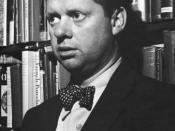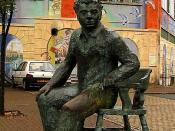There are three poems in which Dylan Thomas directly deals with innocence, and the loss of it to adulthood, and many smaller poems where the theme is mentioned. This is linked in with his theme of time, which is one of the central figures in his poetry. Here I will attempt to uncover how Dylan Thomas uses the theme of innocence in his poetry, and why it works so well.
The first of Dylan's innocent trio I shall look at is titled "ÃÂWas there a time'. In this poem Dylan is deeply regretting the loss of innocence. His use of "Was there..?"�; makes it sound as if he is struggling to remember his innocence "" was there a time.. ah yes, there was a time. The language of the piece is deeply metaphysical, which is inline with the fairy land language of childhood. The "ÃÂdancers with their fiddles' are fantasy idols such as Peter Pan..
the pied piper of Hamlet.. and Alice's rabbit.. taking children to the never-never land of innocence and make believe, away from harsh reality. This paradise of youth they travel to is referred to as a "children's circus"� by Thomas, implying it is a performance put on for their entertainment and to show them new and wondrous sights. In the third line he laments the loss of the sensitivity that accompanies youth and innocence.. in "crying over books"�. Perhaps he also laments the loss of imagination that makes such things become real in a child's mind. The maggot in the fourth line is clearly age.. feeding on the luscious fruit of life.. time here is seen as a villain as in most of Thomas's poetry. (such as Do Not Go Gentle into that Good Night). The fifth line implies that there is no security in time "" no safety, no stability "" which is why the children are "unsafe"�. He continues this safety theme in the sixth line with "what's never known is safest"�; pointing out the irony that, akin to when we dream, we never know innocence was upon us until we wake up. Knowledge, as in the story of Adam and Eve, is portrayed as a corrupting influence.. perhaps then the maggot in the second line is then knowledge not age; the worm within the apple? Ignorance is bliss, bliss is ignorance.. and only in childhood does that ignorance go unpunished, and is cherished rather then derided. This is the theme of the last three lines. The skysigns in line seven refer to the zodiac are a symbol of pre-destined fate.. the fate being presumably that we will lose our innocence. I think also that the use of the word skysigns adds to the mythical fantasy world feel of the piece. "Cleanest are the hands of those who have no arms"� is a biblical reference to Pontious pilot washing his hands of the blood of Jesus, and perhaps Shakespeare's Lady Macbeth. Those who are incapable of doing harm "" ie. children - are the most innocent of all. The heartless ghost seems to be a casual snipe at love.. but I think its also a reference to how ignorance protects children "" life's woes go right through them, and so they are unhurt because they are not solid: they don't really exist in the real world yet. In the last line, the "The blind man sees best"� quote, as well as referring to the general innocence is bliss theme, may also refer to eye of childhood innocence being untainted by the cataract of prejudice: "here are the children, and all they have to teach us"�.
The second poem I will look at here is Fern Hill. This deals again, directly with innocence, this time from the perspective of a child playing in his never-never land of childhood innocence. Instead of dissecting it verse by verse, I will try instead to look at the themes the language throws up, and address each one in turn. Firstly, there is a lot of carefree language in the poem; "young and easy"�, "carefree"�, "heedless"� and "nothing I cared"�. Thomas is directly showing his experience at Fern Hill to be the picture of innocence "" a happy worry-free childhood. There is also an abundance of vocabulary describing new life, freshness and greenery "" the word green is mentioned many times in the poem, both as a descriptor of the poet and of Fern Hill. In fact, color plays a significant role in painting Thomas's picture of innocence on the hill "" white, gold and green all being used to describe innocence, a golden age of happiness and youth and vitality respectively. In addition to color, Thomas uses symbols in order to portray his theme of youth and innocence, of which "calves"�, "lamb white"� and "new made clouds"� are all examples.
Being a deeply metaphysical poem, Fern Hill is full of metaphors. Here I will attempt to isolate and explain some of the deeply metaphorical language inherent in Thomas's work. In the first verse, "under the apple boughs"� could possibly mean under the tree of knowledge; fate hangs in the air like the sun but he's still free from its influence "" perhaps he can't reach the apple of knowledge yet because he's too small in growth. "Trail with daisies and barley"� "" here Thomas is referring to the boy draping daisy chains around trees and leaves "" daisy chains are a symbol of simple child like beauty, like daisies "" small simple flowers. With "The sun that is young once only"� Thomas is referring to his perception of the sun.. he sees the sun in youth so to him it is young, but it will only be young once. In "it was Adam and maiden"� he is referring to the unbroken innocence before the original sin; a life of paradise with his mother nature. In the "sun born over and over"� he is describing the sun in a state of eternal youth, in the childhood myth of the sun dying and being born again each morning. In time holding the subject "ÃÂgreen and dying', Thomas is again referring to his youth which is both green and dying. The fact that time is holding him gives the impression that it is holding him apart from the rest - gentle in its arms like a mother as he sleeps.
Almost all of Thomas's references to innocence are delivered in this poem via the subject's surroundings "" the Fern Hill itself. The landscape of Fern Hill is personified; it is a living breathing vibrant entity; the mother nature of "it was Adam and maiden"�. The descrip tion of the landscape and the way it interacts with the subject is the keystone of Thomas's portrayal of innocence in Fern Hill. It is a fantasy world "" a never-never land of childhood. The animals are "spellbound"�, the dew is "shining"� the chimneys play "tunes"�. It is a description that could be taken right out of the Chronicles of Narnia, Peter Pan or a thousand children's fairy tales. The lax grammar and the childish effervescence (the repetitive use of the word "lovely"� for example) only serve to make this portrayal of youthful innocence all the more poignant. The perspective and the role of the subject is of key import in Fern Hill. It is written from the first person, and the vocabulary used in places along with the perception of innocence ending places the eye of the poet firmly in adulthood, reminiscing about his childhood. I say "his childhood"�, but this could well have been a fictional childhood not experienced by the poet; and there is no conclusive evidence to suggest otherwise. However, based on the vivid descriptions, the intensity of the emotions described and the idolization of youth expressed here and in Thomas's other poems, I feel that the poet is describing his own childhood. This close association between the poet and his poem enforces the feeling of realism that the poem exudes.
The line "My wishes raced through the house high hay"� puts an interesting spin on the poem. Descartes's theorem "" "I think therefore I am"�, and that thoughts are the only true substance of life - is a theme not uncommon in Dylan Thomas's poetry. In "The hunchback in the Park"� for example, the hunchback can be seen as a creator, not just of the "woman figure"� but of the park as a whole. Even the boys that torment him "made the tigers jump out of their eyes"�; suggesting the landscape around them is a product of their emotions and imagination. This theme can be extended to Fern Hill, and is enforced by the subject's unchallenged control of the landscape around him - "I was prince of the apple towns"�, "the calves sang to my horn"� and [I was] honored amongst foxes and pheasants"�. (Egocentricity is a prominent characteristic of children up until adolescence.) To what extent the description is a product of the subject's imagination is open to interpretation; it is possible that the landscape is wholly metaphorical and the poet is just using it to convey his dream-like impressions of childhood. Possible but not really probable "" I think it more likely that Thomas grew up on a farm such as Fern Hill, and the poem is a result of his Rugrat-esque childish perception.
The third poem I will look at is Poem in October. This is again a poem about innocence, but casts it in a different light. Instead of reminiscing, Thomas is rejoicing in the fact that it is still present. To him it has never died, never gone away "" and is as strong now as it ever was in the past. Like Fern Hill, the language is deeply metaphysical and strung with metaphors. Unlike Fern Hill however, these metaphors are laced around a definite progressive "ÃÂplot' "" that of the walk he takes on his birthday.
This journey is the main vein running through the poem. On one level it is a purely physical journey;- he starts off at the harbor of a sea-side town, climbs a hill and looks out over the landscape. However, it is not hard to see a metaphysical journey running parallel to the physical. The harbor represents his birth, the town his childhood, the path to the hill his adolescence, climbing the hill his early adulthood and his current state moving onto middle-age. This is re-enforced by the line "[the gates] of the town closed as the town awoke"�, which I think is a reference to his childhood and the awakening of adolescence; he can never return to his childhood (although he takes a part of it with him). This underlying structure of the poem gives a firm skeleton on which to build on; and as a result there is a definite sense of progression and change from state to state inherent in the poem. This is directly opposite to Fern Hill, which was about time stopping and eternal youth "" the sun being born again each day.
This change of time is depicted in the poem via the seasons. Although it is October, there are constant references to spring and the "summer sun"�, even though it is clearly auterm. While this is confusing on the purely physical level, on the metaphysical level it makes sense "" and it is my belief that in this obvious flaw in the physical interpretation, Thomas is trying to give even the most casual reader an insight into the deeply metaphysical nature of his poem. It is spring when he sets forth from the harbor (the spring of his life) and "summery"� when he reaches his vantage point on the hill. Each time the "weather turns around"� in the last half of the poem, it represents another year passing - he seems to be retracing a path he has trodden year after year. This adds to the impression of time having past in the poem, yet the subject himself hasn't really changed. The links between time represented as seasons, and the landscape and his past adds to this sense of integrity:- he is the earth and time passes over him like seasons; it can only add to him; not take away from him. This portrayal of time is optimistic and is in direct contrast to its portrayal in Was There a Time and to a lesser extent in Fern Hill. Like Fern Hill however, Thomas draws on the surrounding landscape to make metaphorical statements related to the subjects life, and it is this symbiotic relationship that creates much of the poems' effect.
Along with the relationship between the landscape and the subject, there are two main themes inherent in the piece: water and religious imagery. Water is a symbol of life, and it is a prominent feature in the metaphysical landscape Thomas uses. One can almost see his journey as a river; from the harbor the source of the river, the source of life :- the womb, up the hill to end in some stream before ascending into the rainclouds. This enforces the feeling of movement and vitality in the poem: the subject and the landscape are alive. Religious imagery is also inherent everywhere; particularly in connection with the landscape, water and Thomas's main theme of innocence.("priested shore"�, "parables of sun light"�, "green chapels"�) This religious imagery enforces the magnitude of this "journey of the soul"� he is taking, and serves to draw attention to some of the poems deeper aspects "" the meaning of the water, the importance of time (the sun in the sky), and the central theme of innocence at the end.
While the connection between religious imagery and the theme of innocence in the poem may not be direct, I think the "long dead child singing burning"� is highly reminiscent of Christ the child. They share many characteristics "" they both have lived twice - "twice told fields of infancy"� and he is "singing and burning"� "" akin to Christ's suffering on the cross (and similar to the child singing in his chains in Fern Hill). Most importantly the child seems to have the gift of life "" in the sixth stanza when he whispers the truth of his joy to his landscape it "sings alive still in the water and the singingbirds"�. Thomas's depiction of the child reminds me of Oscar Wilde's depiction of Christ in his short story The Selfish Giant, where he is portrayed as a child with the power to imbue life in his very footsteps, and is untainted unlike the older children with the fear of the giant:- the very picture of godly innocence. Whether the child directly represents Christ or not, Thomas defiantly makes him the focus of the poem by the amount of imagery - religious and otherwise - he crowns him with.
Poem in October portrays time and innocence rather more optimistically then the other two poems I am looking at. The child is a symbol of the subject's innocence; undying "" the child is dead in the physical sense because his childhood has ended, but in the metaphysical his innocence has never left him "" "his tears burned my cheeks and his heart moves in mine"�. Time cannot touch him, and is portrayed to have more of a edifying, strengthening effect then the destructive influence in Was There a Time, where time and age are portrayed as a maggot:- something foul to corrupt and sour the fruit of youth. In Poem in October it takes him onto new experiences, in the fifth stanza it leads him on to pastures full of bountiful fruits for example, and there is this sense of positive progression in the poem:- following the river of life that time rolls out before the subject. In Fern Hill time is also personified as a positive entity by and large, a kind of benevolent father watching over the poet, like God. Thomas repeatedly calls time "merciful"� in allowing him this paradise of youth, although there is always the sense that innocence as is the golden age before the original sin :- something marvelous but inherently mortal. The whole sixth stanza is devoted to bittersweet contemplation of the inevitable; the time when the subject must ascend into the "swallow thronged loft"� "" the adult world. There is no sense of this in Poem in October, where time is as insubstantial as the seasons drifting over the subject "" time is a guide, an aid on his journey, not a destructive force. Innocence cannot be destroyed, it is undying, everlasting; the life that invigorates and vitalizes. Again this is different to the painting of innocence In Was There a Time, where innocence is portrayed as a blindfold of comfort, a sanctified ignorance that cannot last "" already the "maggot"� is on their track; the fuse is lit to blow their fantasy world away.
This discrepancy of opinion of innocence in Dylan Thomas's work is puzzling, it suggests that his opinion of innocence changed with age. Fern Hill and Poem in October seem to romanticize time and innocence, and were perhaps written in approximately the same period, although his views on the mortality of innocence had clearly changed. Was There a Time could have been written afterwards, when he was feeling the gall of old age: perhaps this explains the targeting of time as a villain. This discrepancy of opinion is not unusual in his work; like Blake he seems to incorporate starkly conflicting views sometimes even in the same poem "" for example in And Death Shall Have No Domination. It serves to make us think however; to challenge unhesitating faith in each extreme, which I suppose is what art is all about.
Despite these conflicting views on innocence, Poem in October and Fern Hill remain two of Thomas's most popular poems. In fact they remain two of the Nations most popular modern poems, and with Do Not Go Gentle into That Good Night place Thomas as one of the nations most popular poets ever. Why is this exploration of innocence in his work so popular? Seamus Heaney's Black-Berry Picking is another example of an extremely popular poem that deals with the themes of time and mortal innocence. It's not just found in poems either:- Peter Pan, the Pied Piper of Hamlet, even Mary Poppins are all examples of hugely successful stories that explore childhood innocence. What then makes innocence such a powerfully compelling theme? In a sense I think it is because we can relate. The vast majority have experienced a childhood, however brief, where they felt carefree and secure in their innocence. Most of us yearn to experience again that childhood, if just for a brief second to walk the "fire green as grass"� of childhood innocence. Poems and stories that allow us to re-capture that innocence, if just for a brief second, or renew hope that it still exists within us are thus highly prized.
Dylan Thomas's depictions of innocence remain treasured portrayals of the green and golden, and I hope I have gone some way into exploring what makes them so poignant.




